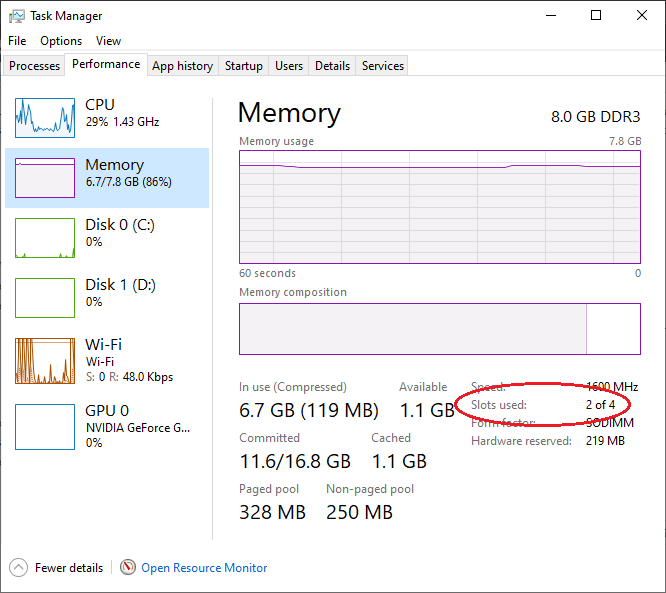- Check Available Memory Slots Linux Usb
- Check Available Memory Slots Linux Upgrade
- Check Available Memory Slots Linux Mint
- Check Available Memory Slots Linux Download
This is our sixth post on getting hardware information. In this post we will see how to get RAM details such as size, speed, make, maximum capacity allowed RAM etc. We already covered some hardware related stuff in this series so far as given below.
Get BIOS, Firmware, Hardware And Drivers Details in Linux/Unix
Later, I moved my role from supporting Solaris systems to Linux systems and I was struggling to get the same piece of info in Linux about the memory bank/slot and how memory is present in each memory bank. Today I got an audit work to validate the system data that someone has filled about Linux servers. As per the above output, I have installed one RAM in DIMM slot 1. The RAM size is 4GB, and it's type and speed is DDR3 and 1067 MHz respectively. Also, we can have the complete RAM details using the following commands. Sudo dmidecode -t memory sudo dmidecode -t memory less sudo dmidecode -t memory more.
Example1: Find RAM size(Total, available, used) in Linux. We can use below five methods to get details.
free
Hotel casino 2ooo mondorf-les-bains luxembourg. Want to understand free command output? check our post on free command.
Gambling counselling edinburgh indiana. Output:
Check Available Memory Slots Linux Usb
top
Check our excelent post to understand Linux top command output.
Casino poker ile maurice des. Output:

Output:
Output:
dmidecode –type memory
or
dmidecode -t 17
Output:
Example 2: Get RAM information like location, Maximum capacity of RAM supported, number of RAM devices present and sa lot info.
Output:
Example 3: Find RAM information like Type of RAM(SD RAM or DDR2/3), Speed, Manufacture etc
Output:
In our next post in this series we will see BIOS and Processer details.
Check Available Memory Slots Linux Upgrade
The following two tabs change content below.- Docker: How to copy files to/from docker container - June 30, 2020
- Anisble: ERROR! unexpected parameter type in action: Fix - June 29, 2020
- FREE: JOIN OUR DEVOPS TELEGRAM GROUPS - August 2, 2019
- Review: Whizlabs Practice Tests for AWS Certified Solutions Architect Professional (CSAP) - August 27, 2018
- How to use ohai/chef-shell to get node attributes - July 19, 2018
The output should look something like this:

Output:
Output:
dmidecode –type memory
or
dmidecode -t 17
Output:
Example 2: Get RAM information like location, Maximum capacity of RAM supported, number of RAM devices present and sa lot info.
Output:
Example 3: Find RAM information like Type of RAM(SD RAM or DDR2/3), Speed, Manufacture etc
Output:
In our next post in this series we will see BIOS and Processer details.
Check Available Memory Slots Linux Upgrade
The following two tabs change content below.- Docker: How to copy files to/from docker container - June 30, 2020
- Anisble: ERROR! unexpected parameter type in action: Fix - June 29, 2020
- FREE: JOIN OUR DEVOPS TELEGRAM GROUPS - August 2, 2019
- Review: Whizlabs Practice Tests for AWS Certified Solutions Architect Professional (CSAP) - August 27, 2018
- How to use ohai/chef-shell to get node attributes - July 19, 2018
The output should look something like this:
Check Available Memory Slots Linux Mint
Here's an example output for the command above:
Check Available Memory Slots Linux Download
Also see: How To Get Hardware Information In Linux

